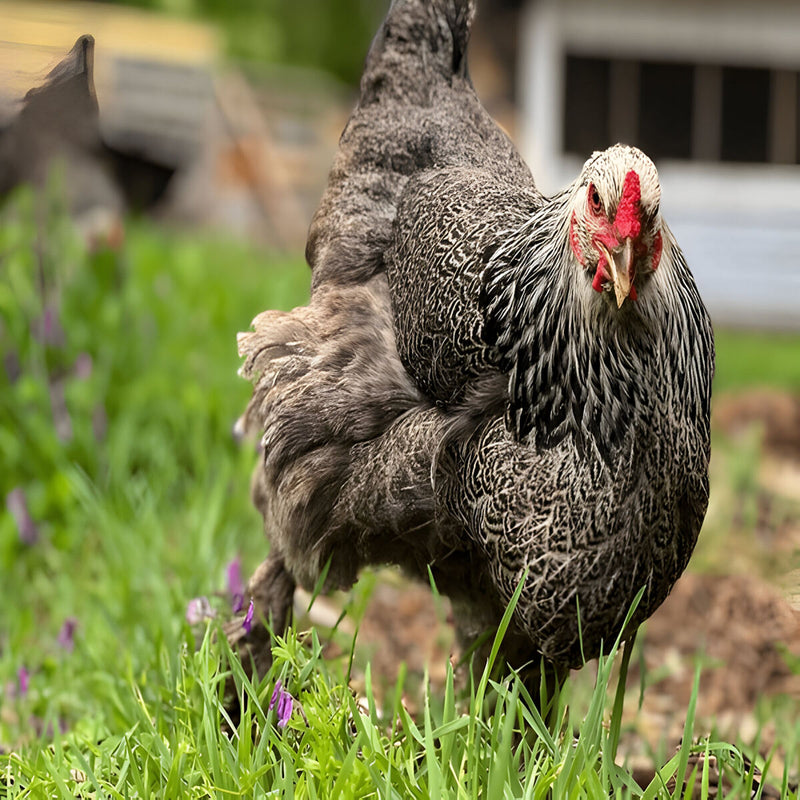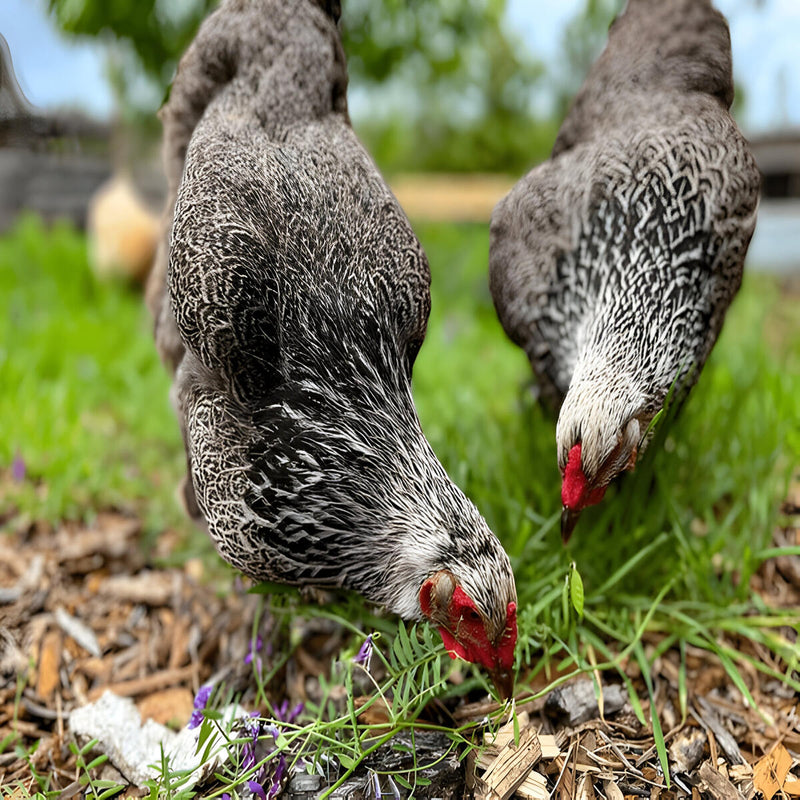-
Egg Size
Medium
-
Egg Quantity
Good (3/wk)
-
Egg Color
Brown
-
Cold Tolerance
Hardy In Winter
-
Heat Tolerance
Not Especially Heat Tolerant
-
Abundance
Common
-
Personality
Calm
-
Size
Large Fowl
-
Feathered feet
Yes
Dark Brahma Chicken
Dark Brahma Chicken
The Dark Brahma is an ancient breed of feather-footed chickens originally from Asia. Known for their calm and gentle nature, these birds are easy to handle and very cold-hardy thanks to their thick feathers and small pea comb. Dark Brahma roosters have striking silvery white and black feathers, while hens feature a beautiful silver-penciled gray pattern.
These chickens are great winter egg layers, producing brown eggs and often making excellent mothers due to their natural brooding instincts. Their large size—roosters up to 12 pounds and hens up to 10 pounds—also makes them good for meat production.
Dark Brahmas adapt well to various climates. They are especially tolerant of cold weather, but in summer, they do fine with access to shade and water. The feathered legs, however, may collect mud or snow, so occasional cleaning might be needed.
Order your Dark Brahma chickens from The Chicken Coop Company today to add these gentle giants to your flock.
Ideal for:
-
Small Farms & Homesteads: Dark Brahmas are perfect for individuals looking to raise a bird that is both practical for meat and eggs and provides aesthetic value with its beautiful plumage.
-
Cold Climates: Their feathered legs and thick plumage make them well-suited for cooler environments, as they provide natural insulation.
-
Families & Beginners: Their friendly nature and ease of care make them ideal for families or those just getting into poultry keeping.
Care Requirements:
-
Space: They require plenty of room to roam, especially due to their size. Free-range environments or large pens are ideal.
-
Feeding: Like most chickens, Dark Brahmas thrive on a balanced diet of high-quality chicken feed, along with access to fresh water and occasional treats such as vegetables and grains.
-
Shelter: These birds need a secure, well-ventilated coop with ample bedding for warmth during winter months. Proper space is essential for their comfort.
Frequently Asked Questions:
What color eggs do Dark Brahma chickens produce?
When considering Dark Brahma chickens, a common question is about the color of their eggs. These chickens are known for laying eggs with a brown shell.
What makes Brahma chickens stand out?
Brahma chickens are prized for their exceptional hardiness. Despite their large size, they are reliable egg layers, capable of producing up to 200 medium-brown eggs annually. Notably, Brahmas excel in cold weather, laying the majority of their eggs from October to May.
When do Brahmas begin laying eggs?
Brahma chickens are slower to mature, which might be why they aren't as widely kept. They typically start laying their first eggs at around 6-7 months of age, compared to the 4-5 months it takes for many other egg-laying breeds.
Are Brahma chickens aggressive?
Brahmas are known for their docile temperament, particularly among roosters. This breed is less prone to rooster-to-rooster aggression, allowing more roosters to coexist peacefully in a flock. Additionally, Brahma roosters may not be as vigorous in mating as roosters of other breeds.
Why are Brahma chickens so expensive?
Brahma chickens command a higher price due to several factors. Their unique size and appearance are part of the appeal, but they are also highly valued for their resilience. Brahmas are recognized for their robust health and ability to thrive in various conditions.
What is the best diet for Brahma chickens?
Brahma chickens don't have unique dietary requirements and can be fed the same diet as the rest of your flock. For chicks, it's recommended to provide a 21% protein Starter Feed until they reach 8 weeks of age, after which they can transition to a standard feed.
Dark Brahma Facts
- Poultry Show Class: Asiatic Class
- Weights – Hen—–9 1/2 lbs
- Rooster——12 lbs
- Pullet—-8 lbs
- Cockerel—–10 lbs
- Purpose and Type: Primary production, Egg Laying, Broody mothers &
- Pet/Secondary meat source
- Egg Shell Color: Brown
- Egg Production: 150+ eggs per year (estimates only)
- Egg Size: Medium,Large
- Temperament: Docile
- Gender Accuracy: 85-90%
- Fertility Percentage: 65-80%
- Broody: Setter
- Mating Ratio: 8 Female to 1 Male
- Roost Height: 2 to 4 feet
- Country of Origin: Asia
- APA: Yes, Recognized by the American Standard of Perfection in 1874.
- TLC: Recovering Status, Considered a sustainable heritage chicken breed
- Breeder Farm Source: Poultry Breeding Farm has been developing our bloodline/strain of pure Dark Brahma since 2013.
Notice: We do not sell items on Amazon or other websites.






